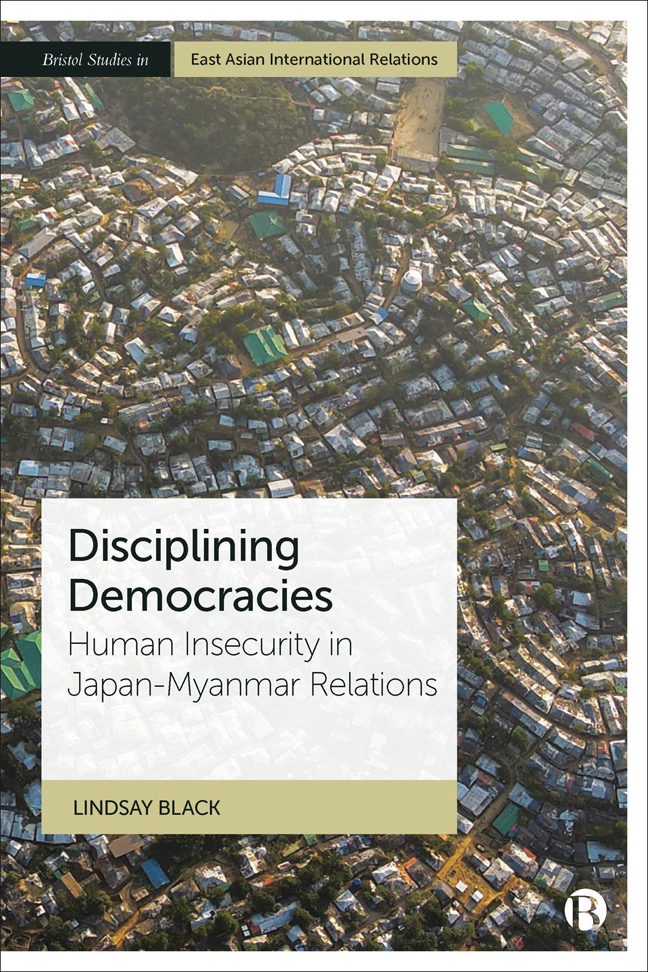Book contents
- Frontmatter
- Dedication
- Contents
- List of Abbreviations
- Acknowledgements
- Introduction
- 1 The Evolution of New Area Studies
- 2 ‘Asia's Liberal Leader’ and Human Insecurity
- 3 Japan as a ‘Bridge’: Facilitating Myanmar's Transition to a ‘Disciplined Democracy’
- 4 Japan and Special Economic Zones in Myanmar
- 5 Meddling for Profit: Japan's Peace-building Role in Myanmar
- 6 Dereliction of Responsibility: Japan's ‘Liberal Leadership’ in the 2016–20 Rakhine Crisis
- Conclusion: The Chimera of Progress
- Notes
- References
- Index
5 - Meddling for Profit: Japan's Peace-building Role in Myanmar
Published online by Cambridge University Press: 25 January 2024
- Frontmatter
- Dedication
- Contents
- List of Abbreviations
- Acknowledgements
- Introduction
- 1 The Evolution of New Area Studies
- 2 ‘Asia's Liberal Leader’ and Human Insecurity
- 3 Japan as a ‘Bridge’: Facilitating Myanmar's Transition to a ‘Disciplined Democracy’
- 4 Japan and Special Economic Zones in Myanmar
- 5 Meddling for Profit: Japan's Peace-building Role in Myanmar
- 6 Dereliction of Responsibility: Japan's ‘Liberal Leadership’ in the 2016–20 Rakhine Crisis
- Conclusion: The Chimera of Progress
- Notes
- References
- Index
Summary
Introduction
As Myanmar transitioned to a ‘disciplined democracy’ following general elections in 2010, so the Abe administration sought to mediate in Myanmar's long-standing ethnic conflicts. By playing a peace-building role in Myanmar, the Abe administration could demonstrate its contribution to the liberal international order. Notably, the Japanese government channelled aid to Myanmar through JICA and enlisted the support of the Nippon Foundation, appointing its head, Sasakawa Yōhei, as a peace envoy to Myanmar. Proponents of this policy maintained that Japan could make a major contribution to resolving Myanmar's ethnic conflicts by working with NGOs to provide aid and assistance, consisting not only of food and medical supplies, but also human resources, technical assistance and financial aid (JICA, 2013d; Manabe, 2013: 104–5; Nippon Foundation, 2013a; Tanaka, 2013).
Though many ethnic minorities have accepted Japanese aid, the Japanese government's ability to act as a mediator in Myanmar's ethnic conflicts has not only been limited, but also divisive. Not only do Japan's peace-building efforts in Myanmar fail to comprehend the complexity of the country's myriad ethnic conflicts, they also ignore the historical role Japan played in developing the Burmese military, during the Second World War, as well as its substantial aid programme to the military government during the Cold War. Japan's ‘peace-makers’ fail to appreciate that their long-standing relations with Myanmar's military elite undermine their trustworthiness as mediators from the standpoint of those ethnic minority groups that have fought the Tatmadaw over the preceding decades.
Japan's foreign policy also does not comprehend how the Tatmadaw's transition to a ‘disciplined democracy’ tackled the civil conflicts separately from the democratization process (Jones, 2014b; Ruzza, 2015) and excluded ethnic minority groups from drafting the constitution (Nilsen, 2013). One indicator of the military's continued control over the transition to democracy can be observed in its willingness to resort to arms against ethnic groups, even repeatedly ignoring calls by the Thein Sein administration to desist from doing so (Nilsen, 2013: 128; South and Joll, 2016: 182).
- Type
- Chapter
- Information
- Disciplining DemocraciesHuman Insecurity in Japan-Myanmar Relations, pp. 101 - 125Publisher: Bristol University PressPrint publication year: 2023



